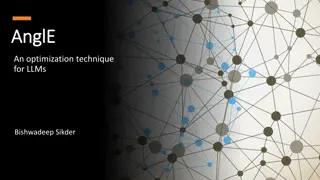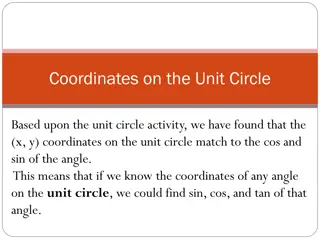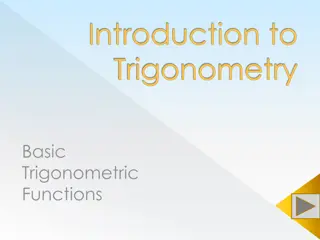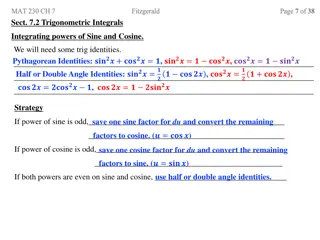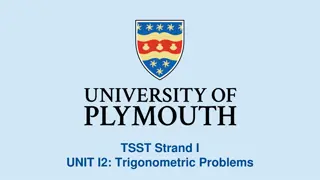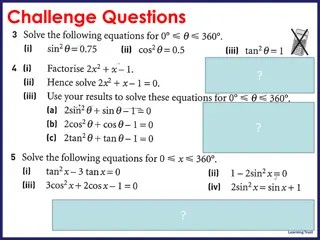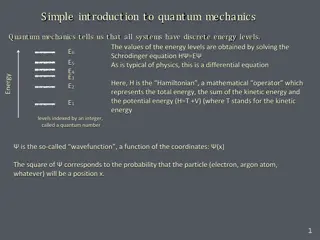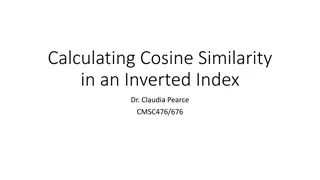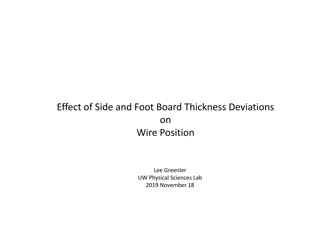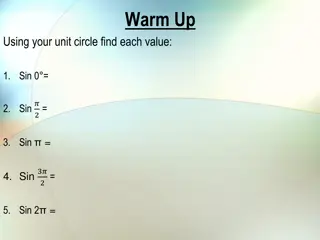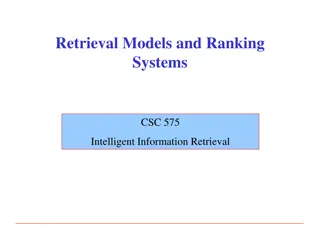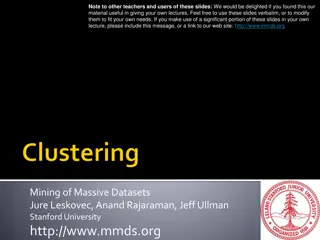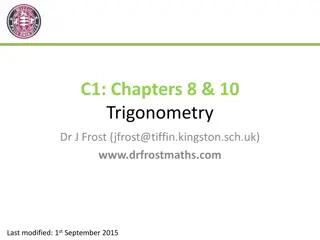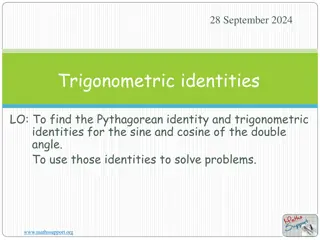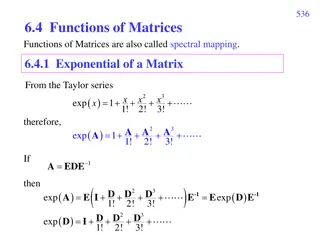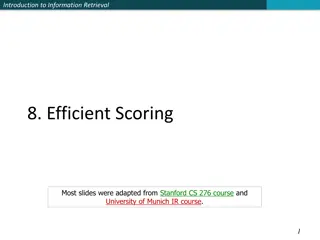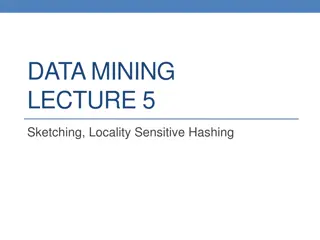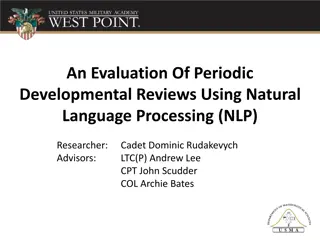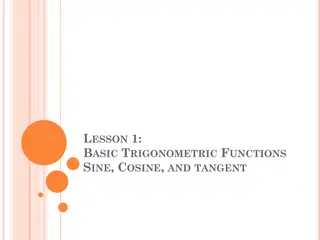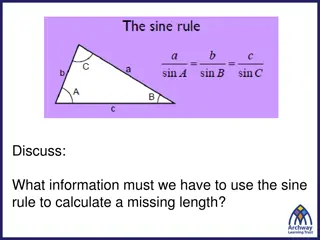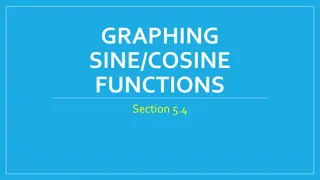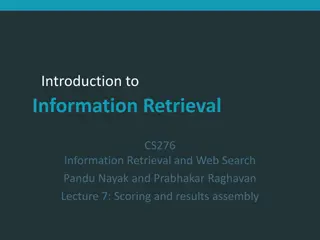AnglE: An Optimization Technique for LLMs by Bishwadeep Sikder
The AnglE model introduces angle optimization to address common challenges like vanishing gradients and underutilization of supervised negatives in Large Language Models (LLMs). By enhancing the gradient and optimization processes, this novel approach improves text embedding learning effectiveness.
12 views • 33 slides
Solving right triangles
Discover how to solve right triangles using trigonometric ratios and angle measures. Explore examples and real-world applications, such as calculating street grades in San Francisco. Learn how to identify angles using sine, cosine, and tangent ratios, and use inverse trigonometric functions to find
4 views • 26 slides
Coordinates on the Unit Circle
Exploring how the coordinates on the unit circle correspond to trigonometric functions like sine, cosine, and tangent. Learn how to find these values for angles on the unit circle and how to apply trigonometry principles when points are not on the unit circle.
12 views • 6 slides
Basic Trigonometry Concepts
Trigonometry is the study of triangles and the relationship between their sides and angles, particularly in right triangles. This introduction covers the basic trigonometric functions such as sine, cosine, and tangent, explaining their ratios in relation to angles and sides. By understanding these f
2 views • 16 slides
Trigonometric Integrals: Strategies and Identities
Learn useful trigonometric identities and strategies for integrating powers of sine and cosine. Understand when to use Pythagorean, Half or Double Angle Identities, and how to handle odd or even powers efficiently. Examples provided for clarity.
1 views • 14 slides
Trigonometric Problems: Mixed, Sine and Cosine Rules
This strand delves into trigonometric problems focusing on triangles with mixed information, exploring side lengths and angle measurements beyond right-angled triangles. It covers mixed problems, sine and cosine rules, applying area of any triangle, and Heron's formula. Engage in various exercises i
6 views • 28 slides
Trigonometry: Identities, Equations, and Problem Solving Techniques
Explore various trigonometric identities, solve trigonometry equations, and learn problem-solving techniques in trigonometry. Discover how to use basic trigonometry to find missing sides, understand trigonometric identities, and tackle challenging trigonometry problems involving sine, cosine, and ta
5 views • 17 slides
Introduction to Quantum Mechanics: Energy Levels and Schrödinger Equation
Quantum mechanics reveals that all systems possess discrete energy levels, determined by solving the Schrödinger equation where the Hamiltonian operator represents total energy. In a particle-in-a-box scenario, potential energy is infinite outside the box. The Schrödinger equation simplifies to a
16 views • 12 slides
Cosine Similarity in Inverted Index for Querying
In this document, Dr. Claudia Pearce explains how to build and query from an inverted index, focusing on calculating the Cosine Similarity. The process involves calculating the dot product of terms in the document and query, updating sums based on term weights, and understanding the significance of
1 views • 15 slides
Structural Equivalence and Similarity Measures in Network Analysis
This content discusses the concepts of structural equivalence and regular equivalence in network analysis. Structural equivalence is based on shared network neighbors, while regular equivalence considers the similarities of neighboring vertices. Various measures, such as cosine similarity and Pearso
4 views • 12 slides
Impact of Board Thickness Deviations on Wire Displacement
In this study by Lee Greenler at UW Physical Sciences Lab, the effect of side and foot board thickness deviations on wire position was analyzed. The displacement of the wire was found to vary based on the cosine factor, with potential displacements up to ~0.5mm near the pin. Different cases were con
3 views • 5 slides
Sine and Cosine Functions in Graphs
Exploring the unit circle to find values of sine at different angles, understanding periodic functions, and graphing sine and cosine functions with variations in amplitude and periods. Learn about vocabulary related to sin waves, amplitude, and period, and discover how to sketch the graph of y = sin
2 views • 15 slides
Intelligent Information Retrieval: Models, Ranking, and Algorithms
Explore the intricacies of retrieval models, ranking systems, and algorithms in the field of Intelligent Information Retrieval. Learn about the construction of indices, matching and scoring processes, distinguishing between exact-match and best-match retrieval, ranking algorithms like Boolean matchi
3 views • 36 slides
Data Structures in High-Dimensional Space
Explore the concept of clustering data points in high-dimensional spaces with distance measures like Euclidean, Cosine, Jaccard, and edit distance. Discover the challenges of clustering in dimensions beyond 2 and the importance of similarity in grouping objects. Dive into applications such as catalo
1 views • 55 slides
Trigonometry Concepts: Graphs, Symmetry, and Laws Explained
Explore trigonometry concepts such as sine, cosine, and tangent graphs, symmetry in trigonometric functions, and laws of trigonometric functions. Understand how to determine values using symmetry and graph analysis. Practice identifying values in the range 0 to 360 for sine, cosine, and tangent func
1 views • 22 slides
Trigonometric Identities for Double Angles
Special identities like the Pythagorean identity and double angle identities for sine and cosine are explored in this content. The Pythagorean identity states that cosine squared plus sine squared equals one, while the double angle identities provide formulas for cosine of double angles. Through the
3 views • 13 slides
Trigonometric Graphs and Patterns
Explore trigonometric graphs, key features, and transformations. Learn to calculate sine and cosine values, recognize symmetries, and work with acute angles for solving trigonometric problems. Dive into the world of sine, cosine, and tangent functions with visual aids and practice exercises.
5 views • 15 slides
Text Similarity Techniques in NLP
Explore various text similarity techniques in Natural Language Processing (NLP), including word order, length, synonym, spelling, word importance, and word frequency considerations. Topics covered include bag-of-words representation, vector-based word similarities, TF-IDF weighting scheme, normalize
7 views • 62 slides
Matrix Functions and Taylor Series in Mathematics
A detailed exploration of functions of matrices, including exponential of a matrix, eigenvector sets, eigenvalues, Jordan-Canonical form, and applications of Taylor series to compute matrix functions like cosine. The content provides a deep dive into spectral mapping, eigenvalues, eigenvectors, and
4 views • 53 slides
Efficient Scoring Techniques in Information Retrieval
Today's focus in Information Retrieval is on efficiently scoring and ranking documents matching a query from an inverted index. The goal is to assign scores to each document and select the top K highest scoring ones. Cutting down CPU usage for scoring while maintaining result quality is essential. T
3 views • 18 slides
Sketching and Locality Sensitive Hashing in Data Mining
Explore the concepts of Jaccard Similarity and Cosine Similarity in data mining, along with their applications in recommendation systems and finding near-duplicates. Discover how Sketching and Locality Sensitive Hashing techniques help in efficiently identifying similar items and solving the Nearest
1 views • 63 slides
Utilizing Natural Language Processing for Periodic Developmental Reviews Analysis
This study focuses on evaluating Periodic Developmental Reviews (PDRs) using Natural Language Processing (NLP) to predict cadet ratings and detect copying of responses. With objectives to analyze text statements in PDRs and investigate the prevalence of response duplication, the research aims to pro
3 views • 19 slides
Basic Trigonometric Functions: Sine, Cosine, and Tangent
Delve into the fundamental trigonometric functions of sine, cosine, and tangent with this introductory lesson. Learn how these functions relate to angles and triangles, and discover their essential properties and applications. Build a strong foundation in trigonometry as you explore the relationship
4 views • 20 slides
Using Sine and Cosine Rules in Geometry
Explore how to determine missing lengths and angles in triangles using the sine and cosine rules. Understand when to apply each rule based on available information. See examples and illustrations to enhance your understanding.
1 views • 15 slides
Evaluation of Transfer Matrix of Plasma Ramp with Squared Cosine Shape
Analyzing the transfer matrix of a plasma ramp with a squared cosine shape using an approximate solution of Mathieu differential equation. The evaluation includes optimization of emittance preservation, theoretical plasma focusing strength, and analytical and numerical solutions. Various methods lik
2 views • 15 slides
Graphing Sine and Cosine Functions: Understanding Amplitude and Period
Learn how to find the amplitude and period of sine and cosine functions from their graphs, how to write equations for these functions, and how to graph them effectively with key points and phase shifts. Master the essential concepts of amplitude, period, and phase shift for graphing trigonometric fu
0 views • 4 slides
Introduction to Information Retrieval: Scoring and Ranking Techniques
Explore the key concepts of scoring and ranking in information retrieval, including tf-idf weighting, cosine similarity, and efficient ranking strategies. Learn how to represent queries as vectors and rank documents based on their proximity to the query. Discover the essentials of computing cosine s
1 views • 48 slides
AI Classification Pitfalls and Cosine Similarity
Explore the challenges of AI classification with scenarios like predisposition testing and cosine similarity calculations. Learn how to avoid common pitfalls in machine learning models.
1 views • 5 slides
Trigonometry: Sine and Cosine Rules
Dive into the world of trigonometry beyond right angles with the Sine and Cosine Rules, exploring how to find side lengths and internal angles in various types of triangles. Discover the Cosine Rule's application in calculating side lengths and angles, with helpful examples and color-coded explanati
2 views • 12 slides
Sine and Cosine Graph Characteristics
Discover the parent graphs of sine and cosine functions and learn how to identify and graph them. Explore transformations, characteristics, and equations of trig functions to deepen your understanding.
3 views • 15 slides
Sine and Cosine Graphs in Advanced Math
Explore the concepts of periodic graphs, sine and cosine functions, oscillation, amplitude, and periods in this advanced math topic. Learn how to graph sine and cosine functions, understand their properties, periods, and amplitudes. Discover the similarities and differences between sine and cosine g
0 views • 9 slides
Calculating Cosine Similarity in Inverted Index - Query and Calculation Process
Learn how to query an inverted index and calculate cosine similarity from the provided content. Understand the process step-by-step to efficiently retrieve relevant information and determine similarity metrics.
4 views • 15 slides
Sine and Cosine Rules in Trigonometry
Explore the Sine and Cosine Rules, essential in solving non-right triangles in trigonometry. Learn how to apply these rules using examples and understand their significance in finding side lengths and internal angles of various triangles.
3 views • 10 slides
Trigonometry Basics: Sine, Cosine, and Tangent Functions Explained
Learn the fundamental concepts of trigonometry focusing on the sine, cosine, and tangent functions in right triangles. Understand side naming conventions, the SOH-CAH-TOA rule, and how to find missing sides using trigonometric functions.
1 views • 20 slides
Ambiguous Case of Sine/Cosine Law
Explore the ambiguous case of the sine law and cosine law, where more than one triangle solution is possible. Learn how to analyze and solve problems involving this scenario. The concept of ambiguity in geometry is illustrated through practical examples and scenarios.
2 views • 17 slides
Trigonometry and Complex Numbers in Mathematics
Explore the fundamentals of trigonometric functions, relationships between sine, cosine, and exponential functions, and the properties of complex numbers in this comprehensive guide. Learn how to differentiate functions involving cosine and sine, and delve into the world of harmonic trigonometric fu
2 views • 15 slides
Cosine Similarity Model in Information Retrieval
Explore the concept of cosine similarity in the context of information retrieval, focusing on the Vector Space Model and Term-Document Matrix. Learn about document representation, query representation, and the computation of cosine similarity for effective information retrieval algorithms.
2 views • 53 slides
Trigonometric Functions: Sine, Cosine, and Tangent Explained
Explore the main features of the sine, cosine, and tangent functions in trigonometry. Understand how to graph each function, identify maximum and minimum values, and differentiate between their characteristics. Dive into the world of trigonometric functions and enhance your mathematical knowledge.
1 views • 9 slides
Convert to Radians and Degrees
Learn how to convert angles to radians and degrees. Practice with examples like -80 and 450 degrees. Explore graphs of sine and cosine functions, understand the period and amplitude, and sketch sine curves. Discover the differences between the sine and cosine functions in trigonometry.
0 views • 12 slides
Understanding the Cosine Rule in Trigonometry
Learn how to use the cosine rule to solve non-right-angled triangles, calculate side lengths, and find angles in trigonometry. Explore practical examples and applications of the cosine rule in mathematics.
1 views • 12 slides
